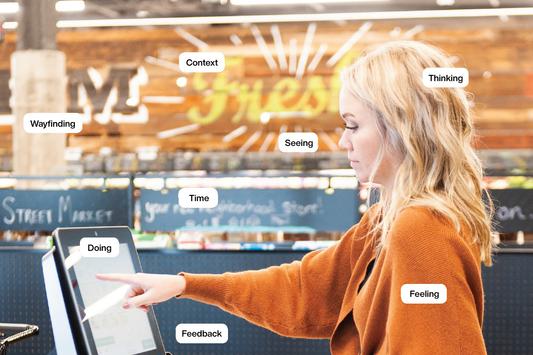
Peopledesign
The Built Environment
Furniture
Lighting
Textiles/Upholstery
Flooring/Carpet
Building Materials
AE Firms
Customer Experience Systems
CX Systems
The emerging discipline of Customer Experience Management requires new approaches to adapting to a changing landscape. Systems thinking is a way to face the complex challenges ahead.
When documenting an experience, or constructing a new one, we often imagine customer journey maps, identifying sequential steps along a path from beginning to end. These maps are a useful abstraction of what is really going on. Reality is much more complicated, of course, something less like a game board and more like chaos theory. It sounds scary, but it’s helpful to remember that even chaos has a rhythm: “within the apparent randomness of chaotic complex systems, there are underlying patterns, interconnectedness, constant feedback loops... and self-organization.” These underlying patterns offer essential clues for building effective experiences.
CX management and service design are about creating effective systems that yield better experiences. The practice involves researching customers, prototyping solutions, measuring effectiveness, and iterating. Effective systems adapt. They learn. Understanding the nature of systems is often called systems thinking, which requires a holistic understanding.
In his seminal book, “The Fifth Discipline,” Peter Senge described five disciplines of a learning organization: personal mastery, mental models, building shared vision, team learning, and systems thinking. Systems thinking – the fifth discipline – integrates the other four. Senge describes how learning organizations are “where new and expansive patterns of thinking are nurtured, where collective aspiration is set free, and where people are continually learning to see the whole together.”
We prepared this talk initially for a CX Management Best Practices Symposium sponsored by CXM@MSU.
Systems thinking is holistic thinking – the effect of the whole beyond the sum of the parts. In her important work, “Thinking in Systems,” Donella Meadows describes a system as having three components: elements, interconnections, and purpose. These three work together to create a functional whole. Understanding the parts, how they interact, and what results, enables systems thinkers to affect outcomes.
You can think of a system as a bathtub. On one end, water is coming in and on the other, water is going out. You can add or drain the water from the tub, controlling inputs and outputs. In the middle is water in the tub. There is storage before the water enters the tub, in the tub, and after it leaves the tub. Values control how much water is in each place. This simple “bathtub model” is a way to think about basic elements and their connections – a system of inputs and outputs. You can measure the flow itself or the amount of water. You may be able to control the rate or volume of the flow, thereby affecting how much water exists in one place or another.
Your digestive tract, schools, football teams, and galaxies are all systems. Looking at complex problems through the lens of system design can allow you to identify elements, how they’re connected, what can be measured, and what can be changed.
What are the elements of CX? There are many, but it can be helpful to think about them as parts of a system. First, there are customers and customer types. Then there are customer service people and other front-line staff. There are places or locations. Many places are digital these days – websites, apps, or other screens and virtual experiences. Time plays a critical role in experience — the customer’s journey from start and finish. You may be thinking about objectives along the way: business objectives like engagement, conversion, and loyalty. Then there’s the customer perspective: Where are the opportunities for communication? What is easy or most convenient? Throughout, you keep an eye on brand coherence and customer expectations.
Next, think about the connections. How do each of these elements relate to one another? What is the strength of the connection, the speed or direction of the flow? What can we monitor for the right feedback at the right time? You can research and analyze what exists in order to consider how things might change. What things group together, and which may be pulled apart? What patterns are emerging?
Ultimately, the system has a purpose – or at least a result. Nearly everything in our world, natural or man-made, is a system. There are inputs and outputs. Systems have intended or unintended consequences. Our ability to see the system as a whole, its parts, connections, causality, and outcomes, enables us to make improvements.
Creating a customer experience involves customer empathy, analyzing elements and connections, synthesizing insights, and prototyping solutions. A CX system will improve by measuring, learning, and adapting in order to move forward. Systems thinking can help organize the work and yield a better result.
You can think of a system as a bathtub. On one end, water is coming in and on the other, water is going out. You can add or drain the water from the tub, controlling inputs and outputs. In the middle is water in the tub. There is storage before the water enters the tub, in the tub, and after it leaves the tub. Values control how much water is in each place. This simple “bathtub model” is a way to think about basic elements and their connections – a system of inputs and outputs. You can measure the flow itself or the amount of water. You may be able to control the rate or volume of the flow, thereby affecting how much water exists in one place or another.
Your digestive tract, schools, football teams, and galaxies are all systems. Looking at complex problems through the lens of system design can allow you to identify elements, how they’re connected, what can be measured, and what can be changed.
What are the elements of CX? There are many, but it can be helpful to think about them as parts of a system. First, there are customers and customer types. Then there are customer service people and other front-line staff. There are places or locations. Many places are digital these days – websites, apps, or other screens and virtual experiences. Time plays a critical role in experience — the customer’s journey from start and finish. You may be thinking about objectives along the way: business objectives like engagement, conversion, and loyalty. Then there’s the customer perspective: Where are the opportunities for communication? What is easy or most convenient? Throughout, you keep an eye on brand coherence and customer expectations.
Next, think about the connections. How do each of these elements relate to one another? What is the strength of the connection, the speed or direction of the flow? What can we monitor for the right feedback at the right time? You can research and analyze what exists in order to consider how things might change. What things group together, and which may be pulled apart? What patterns are emerging?
Ultimately, the system has a purpose – or at least a result. Nearly everything in our world, natural or man-made, is a system. There are inputs and outputs. Systems have intended or unintended consequences. Our ability to see the system as a whole, its parts, connections, causality, and outcomes, enables us to make improvements.
Creating a customer experience involves customer empathy, analyzing elements and connections, synthesizing insights, and prototyping solutions. A CX system will improve by measuring, learning, and adapting in order to move forward. Systems thinking can help organize the work and yield a better result.





